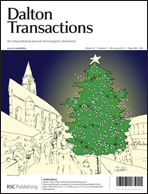A family of 3d–4f heterometallic compounds [Na2FeIII6DyIII2(N3)4(HL)4(CH3O)4(PhCO2)6] (1, H4L = 2-{[(2-hydroxy-3-methoxyphenyl)methylene]amino}-2-(hydroxymethyl)-1,3-propanediol), [Na2FeIII6DyIII2(N3)4(L′)4(CH3O)4(PhCO2)6(H2O)] (2, H3L′ = (E)-2-ethyl-2-(2-hydroxy-3-methoxybenzylideneamino)propane-1,3-diol), [Na2FeIII6DyIII2(N3)4(L′)4(CH3O)4(ButCO2)6] (3) [Na2FeIII6YIII2(N3)4(L′)4(CH3O)4(PhCO2)6(H2O)] (4), and [Na2FeIII6GdIII2(N3)4(L′)4(CH3O)4(PhCO2)6(CH3OH)2] (5) have been prepared using Schiff-base ligands, trinuclear iron precursor complexes, azides and lanthanide nitrates as reactants. In compounds 1 and 2, the structure of the [Na2FeIII6DyIII2] cluster forms a couple of cis,trans-isomers with substitution of methyl for a free hydroxyl group which belongs to the Schiff-base ligand. When the pivalates are employed instead of bulkier benzoates, the trans-[Na2FeIII6DyIII2] clusters act as network nodes in the formation of rhombic grid-like layered structures in compound 3. Compounds 2, 4 and 5 have similar metallic cores, only with different crystal solvent molecules. The magnetic measurements on all the compounds indicate dominant antiferromagnetic interactions between the metal centers.
![Graphical abstract: Synthesis, structures, and magnetic properties of a family of 3d–4f [Na2Fe6Ln2] complexes (Ln = Y, Gd and Dy): effect of ligands on the connection of inorganic subunits](/en/Image/Get?imageInfo.ImageType=GA&imageInfo.ImageIdentifier.ManuscriptID=C2DT31050C&imageInfo.ImageIdentifier.Year=2013)
You have access to this article
 Please wait while we load your content...
Something went wrong. Try again?
Please wait while we load your content...
Something went wrong. Try again?
![Graphical abstract: Synthesis, structures, and magnetic properties of a family of 3d–4f [Na2Fe6Ln2] complexes (Ln = Y, Gd and Dy): effect of ligands on the connection of inorganic subunits](/en/Image/Get?imageInfo.ImageType=GA&imageInfo.ImageIdentifier.ManuscriptID=C2DT31050C&imageInfo.ImageIdentifier.Year=2013)

 Please wait while we load your content...
Please wait while we load your content...